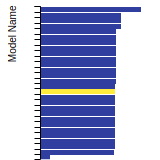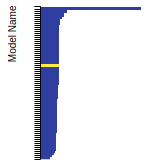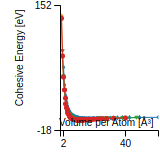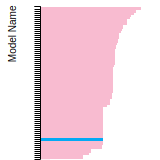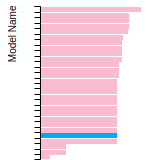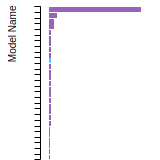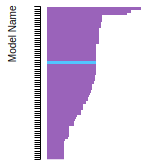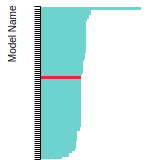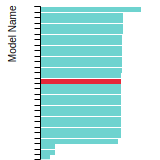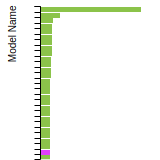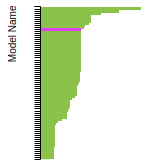 MEAM_LAMMPS_ChoiKimSeol_2017_CoFe__MO_179158257180_002
MEAM_LAMMPS_ChoiKimSeol_2017_CoFe__MO_179158257180_002
| Title
A single sentence description.
|
MEAM Potential for the Co-Fe system developed by Choi et al. (2017) v002 |
|---|---|
| Description
A short description of the Model describing its key features including for example: type of model (pair potential, 3-body potential, EAM, etc.), modeled species (Ac, Ag, ..., Zr), intended purpose, origin, and so on.
|
Interatomic potentials for the Co-Fe binary system has been developed in the framework of the second nearest-neighbor modified embedded-atom method (2NN MEAM) formalism. The potential describes various fundamental alloy behaviors (structural, elastic and thermodynamic behavior of solution and compound phases), mostly in reasonable agreements with experimental data or first-principles calculations. |
| Species
The supported atomic species.
| Co, Fe |
| Disclaimer
A statement of applicability provided by the contributor, informing users of the intended use of this KIM Item.
|
None |
| Content Origin | http://cmse.postech.ac.kr/home_2nnmeam |
| Contributor |
Yongmin Kim |
| Maintainer |
Yongmin Kim |
| Developer |
Won-Mi Choi Yongmin Kim Donghyuk Seol Byeong-Joo Lee |
| Published on KIM | 2023 |
| How to Cite |
This Model originally published in [1] is archived in OpenKIM [2-5]. [1] Choi W-M, Kim Y, Seol D, Lee B-J. Modified embedded-atom method interatomic potentials for the Co-Cr, Co-Fe, Co-Mn, Cr-Mn and Mn-Ni binary systems. Computational Materials Science. 2017;130:121–9. doi:10.1016/j.commatsci.2017.01.002 — (Primary Source) A primary source is a reference directly related to the item documenting its development, as opposed to other sources that are provided as background information. [2] Choi W-M, Kim Y, Seol D, Lee B-J. MEAM Potential for the Co-Fe system developed by Choi et al. (2017) v002. OpenKIM; 2023. doi:10.25950/da349653 [3] Afshar Y, Hütter S, Rudd RE, Stukowski A, Tipton WW, Trinkle DR, et al. The modified embedded atom method (MEAM) potential v002. OpenKIM; 2023. doi:10.25950/ee5eba52 [4] Tadmor EB, Elliott RS, Sethna JP, Miller RE, Becker CA. The potential of atomistic simulations and the Knowledgebase of Interatomic Models. JOM. 2011;63(7):17. doi:10.1007/s11837-011-0102-6 [5] Elliott RS, Tadmor EB. Knowledgebase of Interatomic Models (KIM) Application Programming Interface (API). OpenKIM; 2011. doi:10.25950/ff8f563a Click here to download the above citation in BibTeX format. |
| Citations
This panel presents information regarding the papers that have cited the interatomic potential (IP) whose page you are on. The OpenKIM machine learning based Deep Citation framework is used to determine whether the citing article actually used the IP in computations (denoted by "USED") or only provides it as a background citation (denoted by "NOT USED"). For more details on Deep Citation and how to work with this panel, click the documentation link at the top of the panel. The word cloud to the right is generated from the abstracts of IP principle source(s) (given below in "How to Cite") and the citing articles that were determined to have used the IP in order to provide users with a quick sense of the types of physical phenomena to which this IP is applied. The bar chart shows the number of articles that cited the IP per year. Each bar is divided into green (articles that USED the IP) and blue (articles that did NOT USE the IP). Users are encouraged to correct Deep Citation errors in determination by clicking the speech icon next to a citing article and providing updated information. This will be integrated into the next Deep Citation learning cycle, which occurs on a regular basis. OpenKIM acknowledges the support of the Allen Institute for AI through the Semantic Scholar project for providing citation information and full text of articles when available, which are used to train the Deep Citation ML algorithm. |
This panel provides information on past usage of this interatomic potential (IP) powered by the OpenKIM Deep Citation framework. The word cloud indicates typical applications of the potential. The bar chart shows citations per year of this IP (bars are divided into articles that used the IP (green) and those that did not (blue)). The complete list of articles that cited this IP is provided below along with the Deep Citation determination on usage. See the Deep Citation documentation for more information. 
59 Citations (49 used)
Help us to determine which of the papers that cite this potential actually used it to perform calculations. If you know, click the .
USED (high confidence) B. Waters, D. S. Karls, I. Nikiforov, R. Elliott, E. Tadmor, and B. Runnels, “Automated determination of grain boundary energy and potential-dependence using the OpenKIM framework,” Computational Materials Science. 2022. link Times cited: 5 USED (high confidence) A. Egorov, A. Subramanyam, Z. Yuan, R. Drautz, and T. Hammerschmidt, “Magnetic bond-order potential for iron-cobalt alloys,” Physical Review Materials. 2022. link Times cited: 0 Abstract: For large-scale atomistic simulations of magnetic materials,… read more USED (low confidence) M. Muralles, J. T. Oh, and Z. Chen, “Modified embedded atom method interatomic potentials for the Fe-Al, Fe-Cu, Fe-Nb, Fe-W, and Co-Nb binary alloys,” Computational Materials Science. 2023. link Times cited: 0 USED (low confidence) Y. Deng, H. Li, H. Zong, X. Ding, and J. Sun, “MD simulation of primary radiation damage in fcc multi-principal element alloys: Effect of compositional undulation,” Journal of Nuclear Materials. 2023. link Times cited: 0 USED (low confidence) S. Kuzovchikov, I. Bajenova, A. Khvan, and V. Cheverikin, “Investigation of the hardness and enthalpy of formation of the Sigma phase and the phase equilibria in the Cr-Co-Mn system,” Journal of Alloys and Compounds. 2023. link Times cited: 1 USED (low confidence) O. Klimanova, T. Miryashkin, and A. Shapeev, “Accurate melting point prediction through autonomous physics-informed learning,” Physical Review B. 2023. link Times cited: 0 Abstract: We present an algorithm for computing melting points by auto… read more USED (low confidence) I. A. Alhafez, O. Deluigi, D. Tramontina, C. Ruestes, E. Bringa, and H. Urbassek, “Simulated nanoindentation into single-phase fcc Fe\documentclass[12pt]minimal \usepackageamsmath \usepackagewasysym \usepackageamsfonts \usepackageamssymb \usepackageamsbsy \usepackagemathrsfs \usepackageupgreek \setlength\oddsidemargin-69pt \begindocument$_x$\enddocument,” Scientific Reports. 2023. link Times cited: 1 USED (low confidence) T. Li et al., “Molecular Dynamics Investigation on Micro-Friction Behavior of Cylinder Liner-Piston Ring Assembly,” Tribology Letters. 2023. link Times cited: 0 USED (low confidence) S. Guo et al., “Simultaneously optimizing the strength and ductility of high-entropy alloys by magnetic field-assisted additive manufacturing,” Journal of Alloys and Compounds. 2023. link Times cited: 3 USED (low confidence) K. Gan, D. Yan, and Y. Zhang, “Probing the atomic-scale deformation mechanism of single-crystal nanowires coated with a multi-component alloyed shell,” Computational Materials Science. 2023. link Times cited: 1 USED (low confidence) J. Ji and B.-J. Lee, “Analyzing the effect of Li/Ni intermixing on Ni-rich layered cathode structures using atomistic simulation of the Li–Ni–Mn–Co–O quinary system,” Journal of Power Sources. 2023. link Times cited: 1 USED (low confidence) F. Tan, L. Li, J. Li, B. Liu, P. Liaw, and Q. Fang, “Multiscale modelling of irradiation damage behavior in high entropy alloys,” Advanced Powder Materials. 2023. link Times cited: 3 USED (low confidence) Z. Chen et al., “The interactions between dislocations and displacement cascades in FeCoCrNi concentrated solid-solution alloy and pure Ni,” Journal of Nuclear Materials. 2023. link Times cited: 0 USED (low confidence) Y. Zhou et al., “Influence of icosahedron and icosahedron-like on plastic deformation of Co50Mn50 alloy under compressive conditions,” Journal of Non-Crystalline Solids. 2022. link Times cited: 3 USED (low confidence) A. Babushkin and A. N. Kupriyanov, “Molecular Dynamics Study on Mechanical Stress Formation during Polycrystalline Cr-Film Growth,” Journal of Surface Investigation: X-ray, Synchrotron and Neutron Techniques. 2022. link Times cited: 0 USED (low confidence) M. Muralles, J. Oh, and Z. Chen, “Influence of V addition on the mechanical properties of FeCo alloys: a molecular dynamics study,” Materialia. 2022. link Times cited: 1 USED (low confidence) S. Guo et al., “Overcoming strength-ductility trade-off in high-entropy alloys by tuning chemical short-range order and grain size,” Intermetallics. 2022. link Times cited: 7 USED (low confidence) L. Wei, F. Zhou, S. Wang, W. Hao, Y. Liu, and J. Zhu, “Description of crystal defect properties in BCC Cr with extended Finnis–Sinclair potential,” Multidiscipline Modeling in Materials and Structures. 2022. link Times cited: 0 Abstract: PurposeThe purpose of this study is to propose extended pote… read more USED (low confidence) R. Fereidonnejad, A. O. Moghaddam, and M. Moaddeli, “Modified embedded-atom method interatomic potentials for Al-Ti, Al-Ta, Al-Zr, Al-Nb and Al-Hf binary intermetallic systems,” Computational Materials Science. 2022. link Times cited: 5 USED (low confidence) Y. Li, D. Yang, and W. Qiang, “First-principles study of the effects of solutes on long-range order degree, self-diffusions and antiphase boundary energies in ordered FeCo alloy,” Journal of Magnetism and Magnetic Materials. 2022. link Times cited: 6 USED (low confidence) F. Wu et al., “Lattice inversion potential with neural network corrections for metallic systems,” Computational Materials Science. 2022. link Times cited: 0 USED (low confidence) M. Muralles, J. Oh, and Z. Chen, “Molecular Dynamics Study of Feco Phase Transitions and Thermal Properties Based on an Improved 2nn Meam Potential,” SSRN Electronic Journal. 2022. link Times cited: 3 USED (low confidence) Y. Cui, Z. Chen, S. Gu, W. Yang, and Y. Ju, “Investigating size dependence in nanovoid-embedded high-entropy-alloy films under biaxial tension,” Archive of Applied Mechanics. 2022. link Times cited: 4 USED (low confidence) S. Oh, X.-gang Lu, Q. Chen, and B.-J. Lee, “Pressure dependence of thermodynamic interaction parameters for binary solid solution phases: An atomistic simulation study,” Calphad-computer Coupling of Phase Diagrams and Thermochemistry. 2021. link Times cited: 0 USED (low confidence) S. Chen, Z. Aitken, V. Sorkin, Z. Yu, Z. Wu, and Y.-W. Zhang, “Modified Embedded‐Atom Method Potentials for the Plasticity and Fracture Behaviors of Unary HCP Metals,” Advanced Theory and Simulations. 2021. link Times cited: 3 Abstract: Modified embedded‐atom method (MEAM) potentials have been wi… read more USED (low confidence) N. Dhariwal, A. S. M. Miraz, W. Meng, B. Ramachandran, and C. Wick, “Impact of metal/ceramic interactions on interfacial shear strength: Study of Cr/TiN using a new modified embedded-atom potential,” Materials & Design. 2021. link Times cited: 4 USED (low confidence) S. Paul, M. Muralles, D. Schwen, M. Short, and K. Momeni, “A Modified Embedded-Atom Potential for Fe-Cr-Si Alloys,” The Journal of Physical Chemistry C. 2021. link Times cited: 5 USED (low confidence) Y. L. Li, X. Cheng, W. Duan, and W. Qiang, “Improved ductility by coupled motion of grain boundaries in nanocrystalline B2-FeCo alloys,” Computational Materials Science. 2021. link Times cited: 7 USED (low confidence) M. Meesa, K. Gupta, and K. R. Mangipudi, “A molecular dynamics study of the influence of nucleation conditions on the phase selection in Fe50Mn30Cr10Co10 high entropy alloy,” Materialia. 2021. link Times cited: 1 USED (low confidence) W. Choi et al., “Computational design of V-CoCrFeMnNi high-entropy alloys: An atomistic simulation study,” Calphad-computer Coupling of Phase Diagrams and Thermochemistry. 2021. link Times cited: 12 USED (low confidence) S.-feng Yang et al., “Microstructure and strengthening mechanisms in FCC-structured single-phase TiC–CoCrFeCuNiAl0.3 HEACs with deformation twinning,” Materials Science and Engineering A-structural Materials Properties Microstructure and Processing. 2021. link Times cited: 5 USED (low confidence) Z. Aitken, V. Sorkin, Z. Yu, S. Chen, Z. Wu, and Y.-W. Zhang, “Modified embedded-atom method potentials for the plasticity and fracture behaviors of unary fcc metals,” Physical Review B. 2021. link Times cited: 5 USED (low confidence) S. Guo, H. Chen, and M. Wang, “Research on the dislocation differences of CoCrFeMnNi with different local chemical orders during room temperature tensile test,” Journal of Alloys and Compounds. 2021. link Times cited: 12 USED (low confidence) K. Hsieh, Y.-Y. Lin, C.-H. Lu, J. Yang, P. Liaw, and C.-L. Kuo, “Atomistic simulations of the face-centered-cubic-to-hexagonal-close-packed phase transformation in the equiatomic CoCrFeMnNi high entropy alloy under high compression,” Computational Materials Science. 2020. link Times cited: 21 Abstract: We performed the modified-embedded-atom-method (MEAM) based … read more USED (low confidence) J. Li et al., “Unveiling the atomic-scale origins of high damage tolerance of single-crystal high entropy alloys,” Physical Review Materials. 2020. link Times cited: 13 Abstract: High entropy alloys (HEAs) exhibit an unusual combination of… read more USED (low confidence) Y. Cui, Y. Toku, Y. Kimura, and Y. Ju, “High-strain-rate void growth in high entropy alloys: Suppressed dislocation emission = suppressed void growth,” Scripta Materialia. 2020. link Times cited: 16 USED (low confidence) Y. Cui, Z. Chen, and Y. Ju, “Fracture of Void-Embedded High-Entropy-Alloy Films: A Comprehensive Atomistic Study,” EngRN: Electrochemical Energy Engineering (EngRN) (Topic). 2020. link Times cited: 10 Abstract: Comprehensive molecular dynamics (MD) simulations are perfor… read more USED (low confidence) D. Foley et al., “Simultaneous Twinning and Microband Formation Under Dynamic Compression in a High Entropy Alloy with a Complex Energetic Landscape,” ChemRN: Metals & Alloys (Topic). 2020. link Times cited: 47 Abstract: High entropy alloys (HEAs) have been the subject of signific… read more USED (low confidence) A. Korchuganov, I. Lutsenko, and K. Zolnikov, “Influence of chemical composition of the surface layer on the nucleation of plasticity in CoCrFeMnNi high-entropy alloys,” Journal of Physics: Conference Series. 2020. link Times cited: 2 Abstract: The role of segregation of chemical elements upon free surfa… read more USED (low confidence) Y. Lin et al., “Enhanced Radiation Tolerance of the Ni-Co-Cr-Fe High-Entropy Alloy as Revealed from Primary Damage,” MatSciRN: Other Mechanical Properties & Deformation of Materials (Topic). 2020. link Times cited: 93 Abstract: High-entropy alloys (HEAs) have received much attention for … read more USED (low confidence) I. A. Alhafez, C. Ruestes, E. Bringa, and H. Urbassek, “Nanoindentation into a high-entropy alloy – An atomistic study,” Journal of Alloys and Compounds. 2019. link Times cited: 80 USED (low confidence) Y. Wang et al., “Crystallization kinetics of Ni-Mn alloy thin film using molecular dynamics simulation,” Ferroelectrics. 2019. link Times cited: 0 Abstract: The crystallization kinetics of Ni-Mn alloy thin films is in… read more USED (low confidence) A. Korchuganov and I. S. Lucenko, “Peculiarities of chemical element redistribution near free surfaces in CoCrFeMnNi high-entropy alloys,” IOP Conference Series: Materials Science and Engineering. 2019. link Times cited: 1 Abstract: Based on molecular dynamics and Monte Carlo simulation, the … read more USED (low confidence) A. Korchuganov, “Atomic-scale mechanisms of single crystal plasticity in CoCrFeMnNi high-entropy alloys,” Journal of Physics: Conference Series. 2019. link Times cited: 5 Abstract: The behavior of CoCrFeMnNi high-entropy alloys under mechani… read more USED (low confidence) M. Widom, “Modeling the structure and thermodynamics of high-entropy alloys,” Journal of Materials Research. 2018. link Times cited: 72 Abstract: High-entropy and multiprincipal element alloys present excit… read more USED (low confidence) M. Jang, S. Praveen, H. Sung, J. Bae, J. Moon, and H.-S. Kim, “High-temperature tensile deformation behavior of hot rolled CrMnFeCoNi high-entropy alloy,” Journal of Alloys and Compounds. 2018. link Times cited: 73 USED (low confidence) C.-jun Wu, B.-J. Lee, and X. Su, “Modified embedded-atom interatomic potential for Fe-Ni, Cr-Ni and Fe-Cr-Ni systems,” Calphad-computer Coupling of Phase Diagrams and Thermochemistry. 2017. link Times cited: 60 USED (low confidence) A. Korchuganov, “Formation of defect structure at the atomic level under mechanical loading of CoCrFeMnNi high-entropy alloys.” 2018. link Times cited: 4 USED (low confidence) A. Korchuganov and I. Lutsenko, “Molecular dynamics research of mechanical, diffusion and thermal properties of CoCrFeMnNi high-entropy alloys.” 2018. link Times cited: 11 NOT USED (low confidence) S. Oh, J.-S. Kim, C. S. Park, and B.-J. Lee, “Second nearest-neighbor modified embedded-atom method interatomic potentials for the Mo-M (M = Al, Co, Cr, Fe, Ni, Ti) binary alloy systems,” Computational Materials Science. 2021. link Times cited: 5 NOT USED (low confidence) S. Oh, D. Seol, and B.-J. Lee, “Second nearest-neighbor modified embedded-atom method interatomic potentials for the Co-M (M = Ti, V) binary systems,” Calphad-computer Coupling of Phase Diagrams and Thermochemistry. 2020. link Times cited: 10 NOT USED (high confidence) J. Wang, H. Kwon, H. S. Kim, and B. Lee, “A neural network model for high entropy alloy design,” npj Computational Materials. 2023. link Times cited: 1 NOT USED (high confidence) Y. Li et al., “Molecular dynamics simulation of the transformation of Fe-Co alloy by machine learning force field based on atomic cluster expansion,” Chemical Physics Letters. 2023. link Times cited: 0 NOT USED (high confidence) Y. Cui, Y. Toku, and Y. Ju, “Nanotwinning and tensile behavior in cold-welded high-entropy-alloy nanowires,” Nanotechnology. 2021. link Times cited: 8 Abstract: Since the fabrication technique for high-entropy alloy (HEA)… read more NOT USED (high confidence) Z. Aitken, V. Sorkin, and Y.-W. Zhang, “Atomistic modeling of nanoscale plasticity in high-entropy alloys,” Journal of Materials Research. 2019. link Times cited: 32 Abstract: Lattice structures, defect structures, and deformation mecha… read more NOT USED (high confidence) H. Wang, J. Zhao, W. Liu, and B. Wei, “An anomalous thermal expansion phenomenon induced by phase transition of Fe-Co-Ni alloys,” Journal of Applied Physics. 2018. link Times cited: 5 Abstract: The thermal expansion and the phase transition of Fe-15.6 wt… read more NOT USED (high confidence) K. Yang, L. Lang, H. Deng, F. Gao, and W. Hu, “Modified analytic embedded atom method potential for chromium,” Modelling and Simulation in Materials Science and Engineering. 2018. link Times cited: 5 Abstract: In the present paper, we have developed a modified analytic … read more NOT USED (high confidence) W. Choi, Y. Jo, S. Sohn, S. Lee, and B.-J. Lee, “Understanding the physical metallurgy of the CoCrFeMnNi high-entropy alloy: an atomistic simulation study,” npj Computational Materials. 2018. link Times cited: 436 NOT USED (high confidence) I. Toda-Caraballo, J. Wróbel, D. Nguyen-Manh, P. Pérez, and P. Rivera-Díaz-del-Castillo, “Simulation and Modeling in High Entropy Alloys,” JOM. 2017. link Times cited: 27 |
| Funding | Not available |
| Short KIM ID
The unique KIM identifier code.
| MO_179158257180_002 |
| Extended KIM ID
The long form of the KIM ID including a human readable prefix (100 characters max), two underscores, and the Short KIM ID. Extended KIM IDs can only contain alpha-numeric characters (letters and digits) and underscores and must begin with a letter.
| MEAM_LAMMPS_ChoiKimSeol_2017_CoFe__MO_179158257180_002 |
| DOI |
10.25950/da349653 https://doi.org/10.25950/da349653 https://commons.datacite.org/doi.org/10.25950/da349653 |
| KIM Item Type
Specifies whether this is a Portable Model (software implementation of an interatomic model); Portable Model with parameter file (parameter file to be read in by a Model Driver); Model Driver (software implementation of an interatomic model that reads in parameters).
| Portable Model using Model Driver MEAM_LAMMPS__MD_249792265679_002 |
| Driver | MEAM_LAMMPS__MD_249792265679_002 |
| KIM API Version | 2.2 |
| Potential Type | meam |
| Previous Version | MEAM_LAMMPS_ChoiKimSeol_2017_CoFe__MO_179158257180_001 |
| Grade | Name | Category | Brief Description | Full Results | Aux File(s) |
|---|---|---|---|---|---|
| P | vc-species-supported-as-stated | mandatory | The model supports all species it claims to support; see full description. |
Results | Files |
| P | vc-periodicity-support | mandatory | Periodic boundary conditions are handled correctly; see full description. |
Results | Files |
| P | vc-permutation-symmetry | mandatory | Total energy and forces are unchanged when swapping atoms of the same species; see full description. |
Results | Files |
| N/A | vc-dimer-continuity-c1 | informational | The energy versus separation relation of a pair of atoms is C1 continuous (i.e. the function and its first derivative are continuous); see full description. |
Results | Files |
| P | vc-objectivity | informational | Total energy is unchanged and forces transform correctly under rigid-body translation and rotation; see full description. |
Results | Files |
| P | vc-inversion-symmetry | informational | Total energy is unchanged and forces change sign when inverting a configuration through the origin; see full description. |
Results | Files |
| P | vc-memory-leak | informational | The model code does not have memory leaks (i.e. it releases all allocated memory at the end); see full description. |
Results | Files |
| P | vc-thread-safe | mandatory | The model returns the same energy and forces when computed in serial and when using parallel threads for a set of configurations. Note that this is not a guarantee of thread safety; see full description. |
Results | Files |
| P | vc-unit-conversion | mandatory | The model is able to correctly convert its energy and/or forces to different unit sets; see full description. |
Results | Files |
BCC Lattice Constant
This bar chart plot shows the mono-atomic body-centered cubic (bcc) lattice constant predicted by the current model (shown in the unique color) compared with the predictions for all other models in the OpenKIM Repository that support the species. The vertical bars show the average and standard deviation (one sigma) bounds for all model predictions. Graphs are generated for each species supported by the model.
Cohesive Energy Graph
This graph shows the cohesive energy versus volume-per-atom for the current mode for four mono-atomic cubic phases (body-centered cubic (bcc), face-centered cubic (fcc), simple cubic (sc), and diamond). The curve with the lowest minimum is the ground state of the crystal if stable. (The crystal structure is enforced in these calculations, so the phase may not be stable.) Graphs are generated for each species supported by the model.
Diamond Lattice Constant
This bar chart plot shows the mono-atomic face-centered diamond lattice constant predicted by the current model (shown in the unique color) compared with the predictions for all other models in the OpenKIM Repository that support the species. The vertical bars show the average and standard deviation (one sigma) bounds for all model predictions. Graphs are generated for each species supported by the model.
Dislocation Core Energies
This graph shows the dislocation core energy of a cubic crystal at zero temperature and pressure for a specific set of dislocation core cutoff radii. After obtaining the total energy of the system from conjugate gradient minimizations, non-singular, isotropic and anisotropic elasticity are applied to obtain the dislocation core energy for each of these supercells with different dipole distances. Graphs are generated for each species supported by the model.
(No matching species)FCC Elastic Constants
This bar chart plot shows the mono-atomic face-centered cubic (fcc) elastic constants predicted by the current model (shown in blue) compared with the predictions for all other models in the OpenKIM Repository that support the species. The vertical bars show the average and standard deviation (one sigma) bounds for all model predictions. Graphs are generated for each species supported by the model.
FCC Lattice Constant
This bar chart plot shows the mono-atomic face-centered cubic (fcc) lattice constant predicted by the current model (shown in red) compared with the predictions for all other models in the OpenKIM Repository that support the species. The vertical bars show the average and standard deviation (one sigma) bounds for all model predictions. Graphs are generated for each species supported by the model.
FCC Stacking Fault Energies
This bar chart plot shows the intrinsic and extrinsic stacking fault energies as well as the unstable stacking and unstable twinning energies for face-centered cubic (fcc) predicted by the current model (shown in blue) compared with the predictions for all other models in the OpenKIM Repository that support the species. The vertical bars show the average and standard deviation (one sigma) bounds for all model predictions. Graphs are generated for each species supported by the model.
(No matching species)FCC Surface Energies
This bar chart plot shows the mono-atomic face-centered cubic (fcc) relaxed surface energies predicted by the current model (shown in blue) compared with the predictions for all other models in the OpenKIM Repository that support the species. The vertical bars show the average and standard deviation (one sigma) bounds for all model predictions. Graphs are generated for each species supported by the model.
(No matching species)SC Lattice Constant
This bar chart plot shows the mono-atomic simple cubic (sc) lattice constant predicted by the current model (shown in the unique color) compared with the predictions for all other models in the OpenKIM Repository that support the species. The vertical bars show the average and standard deviation (one sigma) bounds for all model predictions. Graphs are generated for each species supported by the model.
Cubic Crystal Basic Properties Table
Species: CoSpecies: Fe
Creators:
Contributor: karls
Publication Year: 2019
DOI: https://doi.org/10.25950/64cb38c5
This Test Driver uses LAMMPS to compute the cohesive energy of a given monoatomic cubic lattice (fcc, bcc, sc, or diamond) at a variety of lattice spacings. The lattice spacings range from a_min (=a_min_frac*a_0) to a_max (=a_max_frac*a_0) where a_0, a_min_frac, and a_max_frac are read from stdin (a_0 is typically approximately equal to the equilibrium lattice constant). The precise scaling and number of lattice spacings sampled between a_min and a_0 (a_0 and a_max) is specified by two additional parameters passed from stdin: N_lower and samplespacing_lower (N_upper and samplespacing_upper). Please see README.txt for further details.
| Test | Test Results | Link to Test Results page | Benchmark time
Usertime multiplied by the Whetstone Benchmark. This number can be used (approximately) to compare the performance of different models independently of the architecture on which the test was run.
Measured in Millions of Whetstone Instructions (MWI) |
|---|---|---|---|
| Cohesive energy versus lattice constant curve for bcc Co v004 | view | 11090 | |
| Cohesive energy versus lattice constant curve for bcc Fe v004 | view | 8534 | |
| Cohesive energy versus lattice constant curve for diamond Co v004 | view | 10233 | |
| Cohesive energy versus lattice constant curve for diamond Fe v004 | view | 9939 | |
| Cohesive energy versus lattice constant curve for fcc Co v004 | view | 10682 | |
| Cohesive energy versus lattice constant curve for fcc Fe v004 | view | 10086 | |
| Cohesive energy versus lattice constant curve for sc Co v004 | view | 10086 | |
| Cohesive energy versus lattice constant curve for sc Fe v004 | view | 9747 |
Creators: Junhao Li and Ellad Tadmor
Contributor: tadmor
Publication Year: 2019
DOI: https://doi.org/10.25950/5853fb8f
Computes the cubic elastic constants for some common crystal types (fcc, bcc, sc, diamond) by calculating the hessian of the energy density with respect to strain. An estimate of the error associated with the numerical differentiation performed is reported.
| Test | Test Results | Link to Test Results page | Benchmark time
Usertime multiplied by the Whetstone Benchmark. This number can be used (approximately) to compare the performance of different models independently of the architecture on which the test was run.
Measured in Millions of Whetstone Instructions (MWI) |
|---|---|---|---|
| Elastic constants for bcc Co at zero temperature v006 | view | 24589 | |
| Elastic constants for bcc Fe at zero temperature v006 | view | 38053 | |
| Elastic constants for diamond Co at zero temperature v001 | view | 41982 | |
| Elastic constants for fcc Co at zero temperature v006 | view | 37105 | |
| Elastic constants for fcc Fe at zero temperature v006 | view | 26715 | |
| Elastic constants for sc Co at zero temperature v006 | view | 46528 |
Creators:
Contributor: ilia
Publication Year: 2024
DOI: https://doi.org/10.25950/2f2c4ad3
Computes the equilibrium crystal structure and energy for an arbitrary crystal at zero temperature and applied stress by performing symmetry-constrained relaxation. The crystal structure is specified using the AFLOW prototype designation. Multiple sets of free parameters corresponding to the crystal prototype may be specified as initial guesses for structure optimization. No guarantee is made regarding the stability of computed equilibria, nor that any are the ground state.
Creators:
Contributor: ilia
Publication Year: 2025
DOI: https://doi.org/10.25950/866c7cfa
Computes the equilibrium crystal structure and energy for an arbitrary crystal at zero temperature and applied stress by performing symmetry-constrained relaxation. The crystal structure is specified using the AFLOW prototype designation. Multiple sets of free parameters corresponding to the crystal prototype may be specified as initial guesses for structure optimization. No guarantee is made regarding the stability of computed equilibria, nor that any are the ground state.
Creators:
Contributor: brunnels
Publication Year: 2022
DOI: https://doi.org/10.25950/2c59c9d6
Computes grain boundary energy for a range of tilt angles given a crystal structure, tilt axis, and material.
| Test | Test Results | Link to Test Results page | Benchmark time
Usertime multiplied by the Whetstone Benchmark. This number can be used (approximately) to compare the performance of different models independently of the architecture on which the test was run.
Measured in Millions of Whetstone Instructions (MWI) |
|---|---|---|---|
| Relaxed energy as a function of tilt angle for a 100 symmetric tilt grain boundary in bcc Fe v001 | view | 10007098 | |
| Relaxed energy as a function of tilt angle for a 110 symmetric tilt grain boundary in bcc Fe v001 | view | 31027442 | |
| Relaxed energy as a function of tilt angle for a 111 symmetric tilt grain boundary in bcc Fe v001 | view | 17521789 | |
| Relaxed energy as a function of tilt angle for a 111 symmetric tilt grain boundary in fcc Fe v001 | view | 70606117 |
Creators: Daniel S. Karls and Junhao Li
Contributor: karls
Publication Year: 2019
DOI: https://doi.org/10.25950/2765e3bf
Equilibrium lattice constant and cohesive energy of a cubic lattice at zero temperature and pressure.
| Test | Test Results | Link to Test Results page | Benchmark time
Usertime multiplied by the Whetstone Benchmark. This number can be used (approximately) to compare the performance of different models independently of the architecture on which the test was run.
Measured in Millions of Whetstone Instructions (MWI) |
|---|---|---|---|
| Equilibrium zero-temperature lattice constant for bcc Co v007 | view | 12736 | |
| Equilibrium zero-temperature lattice constant for bcc Fe v007 | view | 11706 | |
| Equilibrium zero-temperature lattice constant for diamond Co v007 | view | 13318 | |
| Equilibrium zero-temperature lattice constant for diamond Fe v007 | view | 12663 | |
| Equilibrium zero-temperature lattice constant for fcc Co v007 | view | 12074 | |
| Equilibrium zero-temperature lattice constant for fcc Fe v007 | view | 14193 | |
| Equilibrium zero-temperature lattice constant for sc Co v007 | view | 11411 | |
| Equilibrium zero-temperature lattice constant for sc Fe v007 | view | 12950 |
Creators: Daniel S. Karls and Junhao Li
Contributor: karls
Publication Year: 2019
DOI: https://doi.org/10.25950/c339ca32
Calculates lattice constant of hexagonal bulk structures at zero temperature and pressure by using simplex minimization to minimize the potential energy.
| Test | Test Results | Link to Test Results page | Benchmark time
Usertime multiplied by the Whetstone Benchmark. This number can be used (approximately) to compare the performance of different models independently of the architecture on which the test was run.
Measured in Millions of Whetstone Instructions (MWI) |
|---|---|---|---|
| Equilibrium lattice constants for hcp Co v005 | view | 154989 | |
| Equilibrium lattice constants for hcp Fe v005 | view | 184714 |
Creators:
Contributor: mjwen
Publication Year: 2024
DOI: https://doi.org/10.25950/9d9822ec
This Test Driver uses LAMMPS to compute the linear thermal expansion coefficient at a finite temperature under a given pressure for a cubic lattice (fcc, bcc, sc, diamond) of a single given species.
| Test | Test Results | Link to Test Results page | Benchmark time
Usertime multiplied by the Whetstone Benchmark. This number can be used (approximately) to compare the performance of different models independently of the architecture on which the test was run.
Measured in Millions of Whetstone Instructions (MWI) |
|---|---|---|---|
| Linear thermal expansion coefficient of bcc Fe at 293.15 K under a pressure of 0 MPa v002 | view | 2635835 |
Creators: Matt Bierbaum
Contributor: mattbierbaum
Publication Year: 2019
DOI: https://doi.org/10.25950/6c43a4e6
Calculates the surface energy of several high symmetry surfaces and produces a broken-bond model fit. In latex form, the fit equations are given by:
E_{FCC} (\vec{n}) = p_1 (4 \left( |x+y| + |x-y| + |x+z| + |x-z| + |z+y| +|z-y|\right)) + p_2 (8 \left( |x| + |y| + |z|\right)) + p_3 (2 ( |x+ 2y + z| + |x+2y-z| + |x-2y + z| + |x-2y-z| + |2x+y+z| + |2x+y-z| +|2x-y+z| +|2x-y-z| +|x+y+2z| +|x+y-2z| +|x-y+2z| +|x-y-2z| ) + c
E_{BCC} (\vec{n}) = p_1 (6 \left( | x+y+z| + |x+y-z| + |-x+y-z| + |x-y+z| \right)) + p_2 (8 \left( |x| + |y| + |z|\right)) + p_3 (4 \left( |x+y| + |x-y| + |x+z| + |x-z| + |z+y| +|z-y|\right)) +c.
In Python, these two fits take the following form:
def BrokenBondFCC(params, index):
import numpy
x, y, z = index
x = x / numpy.sqrt(x**2.+y**2.+z**2.)
y = y / numpy.sqrt(x**2.+y**2.+z**2.)
z = z / numpy.sqrt(x**2.+y**2.+z**2.)
return params[0]*4* (abs(x+y) + abs(x-y) + abs(x+z) + abs(x-z) + abs(z+y) + abs(z-y)) + params[1]*8*(abs(x) + abs(y) + abs(z)) + params[2]*(abs(x+2*y+z) + abs(x+2*y-z) +abs(x-2*y+z) +abs(x-2*y-z) + abs(2*x+y+z) +abs(2*x+y-z) +abs(2*x-y+z) +abs(2*x-y-z) + abs(x+y+2*z) +abs(x+y-2*z) +abs(x-y+2*z) +abs(x-y-2*z))+params[3]
def BrokenBondBCC(params, x, y, z):
import numpy
x, y, z = index
x = x / numpy.sqrt(x**2.+y**2.+z**2.)
y = y / numpy.sqrt(x**2.+y**2.+z**2.)
z = z / numpy.sqrt(x**2.+y**2.+z**2.)
return params[0]*6*(abs(x+y+z) + abs(x-y-z) + abs(x-y+z) + abs(x+y-z)) + params[1]*8*(abs(x) + abs(y) + abs(z)) + params[2]*4* (abs(x+y) + abs(x-y) + abs(x+z) + abs(x-z) + abs(z+y) + abs(z-y)) + params[3]
| Test | Test Results | Link to Test Results page | Benchmark time
Usertime multiplied by the Whetstone Benchmark. This number can be used (approximately) to compare the performance of different models independently of the architecture on which the test was run.
Measured in Millions of Whetstone Instructions (MWI) |
|---|---|---|---|
| Broken-bond fit of high-symmetry surface energies in bcc Fe v004 | view | 80642 |
Creators:
Contributor: efuem
Publication Year: 2023
DOI: https://doi.org/10.25950/fca89cea
Computes the monovacancy formation energy and relaxation volume for cubic and hcp monoatomic crystals.
| Test | Test Results | Link to Test Results page | Benchmark time
Usertime multiplied by the Whetstone Benchmark. This number can be used (approximately) to compare the performance of different models independently of the architecture on which the test was run.
Measured in Millions of Whetstone Instructions (MWI) |
|---|---|---|---|
| Monovacancy formation energy and relaxation volume for bcc Fe | view | 373771 | |
| Monovacancy formation energy and relaxation volume for hcp Co | view | 551786 |
Creators:
Contributor: efuem
Publication Year: 2023
DOI: https://doi.org/10.25950/c27ba3cd
Computes the monovacancy formation and migration energies for cubic and hcp monoatomic crystals.
| Test | Test Results | Link to Test Results page | Benchmark time
Usertime multiplied by the Whetstone Benchmark. This number can be used (approximately) to compare the performance of different models independently of the architecture on which the test was run.
Measured in Millions of Whetstone Instructions (MWI) |
|---|---|---|---|
| Vacancy formation and migration energy for bcc Fe | view | 1613393 | |
| Vacancy formation and migration energy for hcp Co | view | 5294050 |
| Test | Error Categories | Link to Error page |
|---|---|---|
| Elastic constants for diamond Fe at zero temperature v001 | other | view |
| Elastic constants for sc Fe at zero temperature v006 | other | view |
ElasticConstantsHexagonal__TD_612503193866_004
| Test | Error Categories | Link to Error page |
|---|---|---|
| Elastic constants for hcp Co at zero temperature v004 | other | view |
| Elastic constants for hcp Fe at zero temperature v004 | other | view |
EquilibriumCrystalStructure__TD_457028483760_003
GrainBoundaryCubicCrystalSymmetricTiltRelaxedEnergyVsAngle__TD_410381120771_003
SurfaceEnergyCubicCrystalBrokenBondFit__TD_955413365818_004
| Test | Error Categories | Link to Error page |
|---|---|---|
| Broken-bond fit of high-symmetry surface energies in bcc Fe v004 | other | view |
No Driver
| Verification Check | Error Categories | Link to Error page |
|---|---|---|
| DimerContinuityC1__VC_303890932454_005 | other | view |
| ForcesNumerDeriv__VC_710586816390_003 | other | view |
| MEAM_LAMMPS_ChoiKimSeol_2017_CoFe__MO_179158257180_002.txz | Tar+XZ | Linux and OS X archive |
| MEAM_LAMMPS_ChoiKimSeol_2017_CoFe__MO_179158257180_002.zip | Zip | Windows archive |
This Model requires a Model Driver. Archives for the Model Driver MEAM_LAMMPS__MD_249792265679_002 appear below.
| MEAM_LAMMPS__MD_249792265679_002.txz | Tar+XZ | Linux and OS X archive |
| MEAM_LAMMPS__MD_249792265679_002.zip | Zip | Windows archive |
